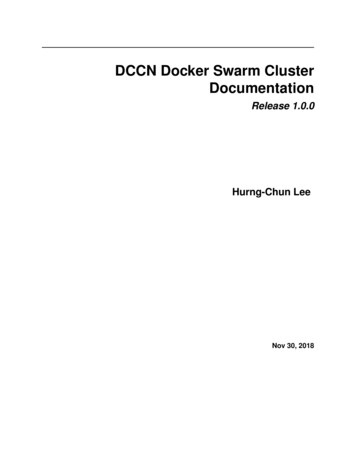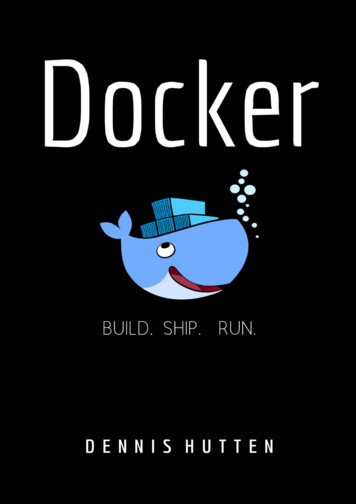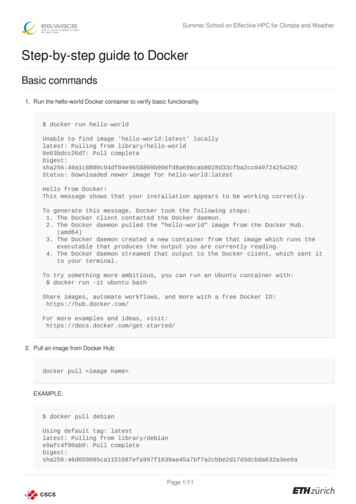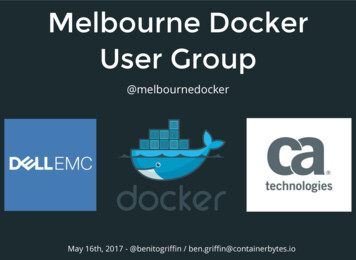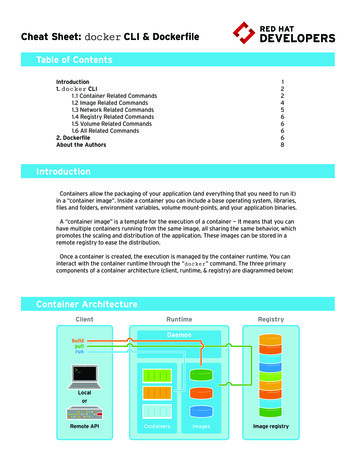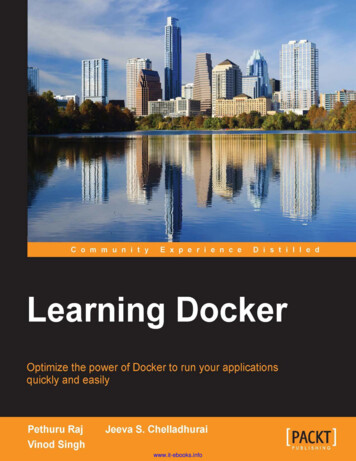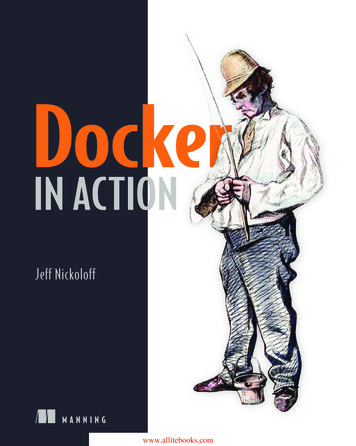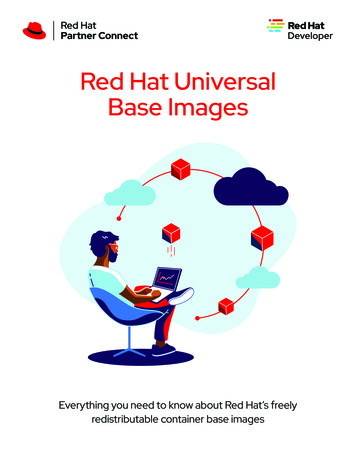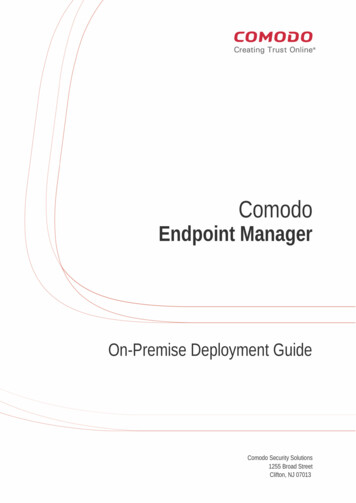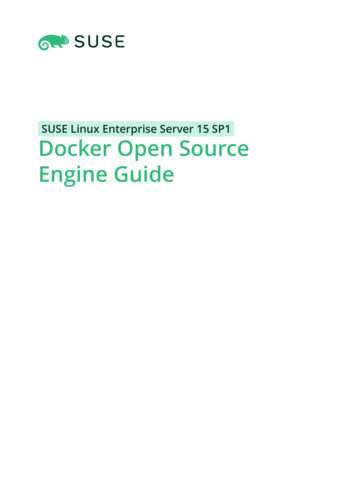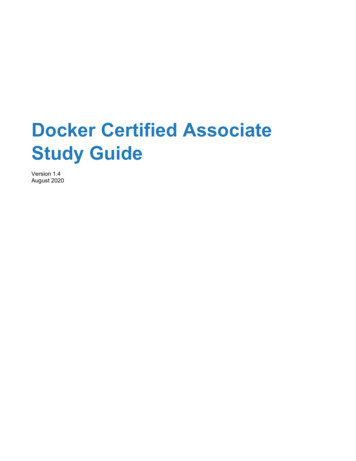
Transcription
Docker Certified AssociateStudy GuideVersion 1.4August 2020
IntroductionThis examination is based upon critical job activities a Docker Certified Associate performs. The skills andknowledge certified by this examination represent a level of expertise where a certified Docker Associatecan: Run containerized applications from pre-existing images stored in a centralized registryDeploy images across the clusterTriage and resolve issue reports from stakeholders and resolveStandup up on Enterprise clusters with one UCP manager, one DTR replica, and one worker nodeMigrate traditional applications to containersConfigure and troubleshoot Docker enginePerform general maintenance and configurationCandidates for this certification should have at least six months to one year of experience with Docker,including exposure to the Docker Enterprise Edition. The knowledge, skills and experience required at thislevel should also include: container securityexperience with at least one cloud providerconfiguration management toolsLinux and/or Windows ServerThe skills and knowledge this examination measures are derived from an understanding of the jobs ofcurrent Docker users. A team of highly qualified Docker experts defined the test content and developed thetest items.Note: This examination blueprint includes weighting, test objectives, and example content. Exampletopics and concepts are included to clarify the test objectives; they should not be construed as acomprehensive listing of all the content of this examination.The following table lists the domains measured by this examination and the extent to which they arerepresented.Name of Domain% of ExamOrchestration25%Image Creation, Management, and Registry20%Installation and Configuration15%Networking15%Security15%Storage and Volumes10%Page 2
Examination FormatThe examination contains 55 questions consisting of 13 multiple choice items and 42 discrete option multiplechoice (DOMC) items. Multiple-choice: Examinees are presented a question with at least four response options and mustselect one or more options to best answer the question. Distracters or wrong answers will bepresented as response options. These are response options that examinees with incompleteknowledge or skill might choose, as they are generally plausible responses fitting into the contentarea defined by the test objective. Discrete Option Multiple Choice (DOMC): DOMC items represent a relatively simple, but usefulchange in the delivery of multiple-choice questions. Options are randomly presented, one at a time.For each presented option, the examinee chooses YES or NO to indicate if the option is correct. Tofamiliarize yourself with DOMC, try out this practice exam.Page 3
Content LimitsDomain 1: Orchestration (25% of exam)Content may include the following: Complete the setup of a swarm mode cluster, with managers and worker nodes Describe and demonstrate how to extend the instructions to run individual containers intorunning services under swarm. Describe the importance of quorum in a swarm cluster. Describe the difference between running a container and running a service. Interpret the output of “docker inspect” commands. Convert an application deployment into a stack file using a YAML compose file with "dockerstack deploy" Manipulate a running stack of services. Describe and demonstrate orchestration activities. Increase the number of replicas. Add networks, publish ports. Mount volumes. Describe and demonstrate how to run replicated and global services. Apply node labels to demonstrate placement of tasks. Describe and demonstrate how to use templates with “docker service create”. Identify the steps needed to troubleshoot a service not deploying. Describe how a Dockerized application communicates with legacy systems. Describe how to deploy containerized workloads as Kubernetes pods and deployments. Describe how to provide configuration to Kubernetes pods using configMaps and secrets.Domain 2: Image Creation, Management, and Registry (20% of exam)Content may include the following: Describe the use of Dockerfile. Describe options, such as add, copy, volumes, expose, entry point. Identify and display the main parts of a Dockerfile. Describe and demonstrate how to create an efficient image via a Dockerfile. Describe and demonstrate how to use CLI commands to manage images, such as list,delete, prune, rmi.Page 4
Describe and demonstrate how to inspect images and report specific attributes using filterand format Describe and demonstrate how to tag an image. Describe and demonstrate how to apply a file to create a Docker image. Describe and demonstrate how to display layers of a Docker image Describe and demonstrate how to modify an image to a single layer. Describe and demonstrate registry functions. Deploy a registry. Log into a registry. Utilize search in a registry. Push an image to a registry. Sign an image in a registry. Pull and delete images from a registry.Domain 3: Installation and Configuration (15% of exam)Content may include the following: Describe sizing requirements for installation. Describe and demonstrate the setup of repo, selection of a storage driver, and installationof the Docker engine on multiple platforms. Describe and demonstrate configuration of logging drivers (splunk, journald, etc.). Describe and demonstrate how to set up swarm, configure managers, add nodes, andsetup the backup schedule. Describe and demonstrate how to create and manage user and teams. Describe and demonstrate how to configure the Docker daemon to start on boot. Describe and demonstrate how to use certificate-based client-server authentication toensure a Docker daemon has the rights to access images on a registry. Describe the use of namespaces, cgroups, and certificate configuration. Describe and interpret errors to troubleshoot installation issues without assistance. Describe and demonstrate the steps to deploy the Docker engine, UCP, and DTR on AWSand on-premises in an HA configuration. Describe and demonstrate how to configure backups for UCP and DTR.Page 5
Domain 4: Networking (15% of exam)Content may include the following: Describe the Container Network Model and how it interfaces with the Docker engine andnetwork and IPAM drivers. Describe the different types and use cases for the built-in network drivers. Describe the types of traffic that flow between the Docker engine, registry and UCPcontrollers. Describe and demonstrate how to create a Docker bridge network for developers to use fortheir containers. Describe and demonstrate how to publish a port so that an application is accessibleexternally. Identify which IP and port a container is externally accessible on. Compare and contrast “host” and “ingress” publishing modes. Describe and demonstrate how to configure Docker to use external DNS. Describe and demonstrate how to use Docker to load balance HTTP/HTTPs traffic to anapplication (Configure L7 load balancing with Docker EE). Understand and describe the types of traffic that flow between the Docker engine, registry,and UCP controllers Describe and demonstrate how to deploy a service on a Docker overlay network. Describe and demonstrate how to troubleshoot container and engine logs to resolveconnectivity issues between containers. Describe how to route traffic to Kubernetes pods using ClusterIP and NodePort services. Describe the Kubertnetes’ container network model.Domain 5: Security (15% of exam)Content may include the following: Describe security administration and tasks. Describe the process of signing an image. Describe default engine security. Describe swarm default security. Describe MTLS. Describe identity roles. Compare and contrast UCP workers and managers. Describe the process to use external certificates with UCP and DTR. Describe and demonstrate that an image passes a security scan.Page 6
Describe and demonstrate how to enable Docker Content Trust. Describe and demonstrate how to configure RBAC with UCP. Describe and demonstrate how to integrate UCP with LDAP/AD. Describe and demonstrate how to create UCP client bundles.Domain 6: Storage and Volumes (10% of exam)Content may include the following: Identify the correct graph drivers to uses with various operating systems. Describe and demonstrate how to configure devicemapper. Compare and contrast object and block storage and when they should be used. Describe how an application is composed of layers and where these layers reside on thefilesystem. Describe the use of volumes are used with Docker for persistent storage. Identify the steps to take to clean up unused images on a filesystem and DTR. Describe and demonstrate how storage can be used across cluster nodes. Describe how to provision persistent storage to a Kubernetes pod using persistentVolumes. Describe the relationship between container storage interface drivers, storageClass,persistentVolumeClaim and volume objects in Kubernetes.Sample Test QuestionsThe following supplemental information is displayed above each DOMC item on the live exam:Page 7
Page 8
Page 9
Page 10
Answer KeyQ1 Option 3Q2 Option 1Q3 Option 1Q4 AQ5 BQ6 AQ7 Option 3Q8 CQ9 CPage 11
NotesPage 12
Study Guide . Version 1.4 . August 2020 . Page 2 . Introduction This examination is based upon critical job activities a Docker Certified Associate performs. The skills and . Describe the different types and use cases for the built-in network drivers. Describe the types of traffic that flow between the Docker engine, registry and UCP

